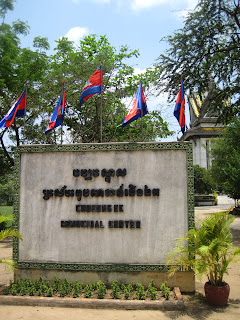We all jumped into the tuk-tuk and off we went to the 'Killing Fields' and S21 prison to learn a little about Pol Pot's genocide campaign.
Choeung Ek, the killing fields
As the Khmer Rouge were starting their reign of terror, Toul Svay Prey Secondary School, in a quiet neighbourhood, was transformed into a primitive prison and interrogation centre. Corrugated iron and barbed wire were installed around the perimeter and classrooms were divided into cells. From 1975 to 1979 as estimated 20.000 victims were inprisioned in Security Prison 21, or S21 as it became known. Teachers, students, doctors, monks and peasents suspected of anti-revolutionary behaviour were brought here, often with their espouses and children. They were subjected to horrific tortures and then killed or taken to extermination camps outside the city.
the mass graves today look more like a swamp
we spent some time around discussing the subject...
victims of cambodia's war mines. Check out the huge smile!!! Closer...
Introducing Paolo and Satvinda.
Paolo, 36, from Milaaaano(!!!), a natural born traveller, been to Thailand and SE Asia many times. His mother lived in Thailand for a few years long time ago and some friends live in the island of Koh Samui. He goes to Brazil for several months within the last 6 years so we could actually have fun speaking brazillian portuguese, including brasilian naughty dirty words... lol Good laugh! Dinamic strong minded italiano who takes no bullshit from the locals when it comes to bargain for prices. I though I was tough on that until I met this 'gentleman'...
Satvinda, a Londoner, indian roots, been travelling on her own for 4 months now. Well... as far as I gathered she hops from group to group: on the boat to Cambodia she had left a group of traveller friends behind, she was now 'forming' another group and when she left Phnom Penh she stuck to another group... Clever way to travel: own your own, but not on your own! A nice girl anyway... with personality... ;)
Introducing Domenico.
Domenico, 29, da Veneziiiiia(!!!), travelling for a few months too, met Paolo 2 months before in Thailand and they both been travelling together. Very laied back... Perhaps a little too laied back... but also good fun! Veramente Bee uh tee fuuul acc sente! Dai !
The city centre is crossed by splendours canals. The sewage waters running in them are so grey and thick that one can almost skate roll over...
Nice...

Introduction to the Tuol Sleng Genocide Museum. To read and learn...
According to the Documentary Centre of Cambodia, there are about 189 prisons, 380 killing fields and 19.403 mass graves. In Cambodia, no family could escape from the genocidal policy of Democratic Kampuchea.
The school...

The classrooms...




I particularly like Rule no. 6 ...
Tough... We ain't messn about!!
Torture pictures were available at the exhibition but were too shocking to be reproduced...
The Khmer Rouge, Pol Pot and his crew...
Doctors, teachers, writers, educated people and their families were tortured and killed. Even wearing glasses was an indication of intelligence, a 'crime' punished by death.
When I visit places such this it is not with the intent of feeding some sort of a morbid pleasure within. Instead, by occasionally visiting such dramatic venues, one can only keep learning more about the human condition and its extreme behaviours so one can become a better person...
say what? Cambodia's Independence Monument!








































Macábro....infelizmente por esses lados houve mta gente , se é q se podem chamar assim, a achar-se superior aos outros e a infligir maldade.....ainda infelizmente ainda existem uns assim...
ReplyDeleteBolas!!!!!
ReplyDeleteLonga e triste esta história dos Kmers Vermelhos no Cambodja. Não há mal algum em saber e divulgar estes factos que constituiram um dos maiores e gratuitos genocídeos da humanidade. Bom trabalho Miguel.
ReplyDelete